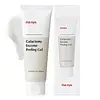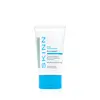What's inside
What's inside
 Key Ingredients
Key Ingredients

 Benefits
Benefits

 Concerns
Concerns

 Ingredients Side-by-side
Ingredients Side-by-side

Galactomyces Ferment Filtrate 24.8%
HumectantHydrolyzed Collagen Extract
Skin ProtectingSqualane
EmollientCetearyl Alcohol
EmollientGlycerin
HumectantCaprylic/Capric Triglyceride
MaskingPropanediol
Solvent1,2-Hexanediol
Skin ConditioningNiacinamide
SmoothingPhaseolus Radiatus Seed Water
Hamamelis Virginiana Water
AstringentOryza Sativa Bran Water
MaskingRosa Centifolia Flower Water
Skin ConditioningPolyglyceryl-6 Stearate
EmollientPanthenol
Skin ConditioningCentella Asiatica Extract
CleansingGlycyrrhiza Uralensis Root Extract
Skin ConditioningSaccharomyces Ferment Filtrate
HumectantDioscorea Japonica Root Extract
Skin ConditioningSalix Alba Bark Extract
AstringentSimmondsia Chinensis Seed Oil
EmollientBetaine
HumectantCentella Asiatica Leaf Extract
Skin ConditioningMangifera Indica Seed Butter
Skin ConditioningPolyglyceryl-2 Stearate
EmulsifyingGlyceryl Stearate
EmollientStearyl Alcohol
EmollientLaminaria Japonica Extract
Skin ProtectingCassia Italica Leaf Extract
Skin ConditioningRosmarinus Officinalis Leaf Extract
AntimicrobialChamomilla Recutita Flower Extract
MaskingCamellia Sinensis Leaf Extract
AntimicrobialSh-Oligopeptide-1
Skin ConditioningSh-Oligopeptide-2
Skin ConditioningSh-Polypeptide-1
Skin ConditioningSh-Polypeptide-2
Skin ConditioningSodium Hyaluronate
HumectantPolygonum Cuspidatum Root Extract
AntioxidantScutellaria Baicalensis Root Extract
AstringentEthylhexylglycerin
Skin ConditioningMacadamia Integrifolia Seed Oil
Skin ConditioningPropanediol Dicaprylate
EmollientBeta-Glucan
Skin ConditioningHydrogenated Olive Oil Unsaponifiables
EmollientEnantia Chlorantha Bark Extract
Skin ConditioningOleanolic Acid
Skin ConditioningPolyglyceryl-6 Behenate
Emulsion StabilisingAcanthopanax Senticosus Root Extract
Skin ConditioningGlutathione
Maltodextrin
AbsorbentHydrolyzed Avocado Protein
Skin ConditioningTrehalose
HumectantGlyceryl Caprylate
EmollientCeramide NP
Skin ConditioningCarnosine
Skin ConditioningViscum Album Extract
Skin ConditioningRosa Damascena Flower Oil
MaskingRose Flower Oil
MaskingAdenosine
Skin ConditioningGalactomyces Ferment Filtrate 24.8%, Hydrolyzed Collagen Extract, Squalane, Cetearyl Alcohol, Glycerin, Caprylic/Capric Triglyceride, Propanediol, 1,2-Hexanediol, Niacinamide, Phaseolus Radiatus Seed Water, Hamamelis Virginiana Water, Oryza Sativa Bran Water, Rosa Centifolia Flower Water, Polyglyceryl-6 Stearate, Panthenol, Centella Asiatica Extract, Glycyrrhiza Uralensis Root Extract, Saccharomyces Ferment Filtrate, Dioscorea Japonica Root Extract, Salix Alba Bark Extract, Simmondsia Chinensis Seed Oil, Betaine, Centella Asiatica Leaf Extract, Mangifera Indica Seed Butter, Polyglyceryl-2 Stearate, Glyceryl Stearate, Stearyl Alcohol, Laminaria Japonica Extract, Cassia Italica Leaf Extract, Rosmarinus Officinalis Leaf Extract, Chamomilla Recutita Flower Extract, Camellia Sinensis Leaf Extract, Sh-Oligopeptide-1, Sh-Oligopeptide-2, Sh-Polypeptide-1, Sh-Polypeptide-2, Sodium Hyaluronate, Polygonum Cuspidatum Root Extract, Scutellaria Baicalensis Root Extract, Ethylhexylglycerin, Macadamia Integrifolia Seed Oil, Propanediol Dicaprylate, Beta-Glucan, Hydrogenated Olive Oil Unsaponifiables, Enantia Chlorantha Bark Extract, Oleanolic Acid, Polyglyceryl-6 Behenate, Acanthopanax Senticosus Root Extract, Glutathione, Maltodextrin, Hydrolyzed Avocado Protein, Trehalose, Glyceryl Caprylate, Ceramide NP, Carnosine, Viscum Album Extract, Rosa Damascena Flower Oil, Rose Flower Oil, Adenosine
Caprylic/Capric Triglyceride
MaskingMagnesium Oxide
AbsorbentGlycerin
HumectantOleth-20
CleansingGlyceryl Stearate
EmollientSodium Bicarbonate
AbrasiveZeolite
AbsorbentPolylactic Acid
AbrasiveTrihydroxystearin
Skin ConditioningWater
Skin ConditioningMentha Piperita Oil
MaskingOlea Europaea Fruit Oil
MaskingPrunus Amygdalus Dulcis Oil
Skin ConditioningSqualane
EmollientMenthol
MaskingRosmarinus Officinalis Leaf Oil
MaskingTocopheryl Acetate
AntioxidantTetrahexyldecyl Ascorbate
AntioxidantMagnesium Ascorbyl Phosphate
AntioxidantSodium Ascorbyl Phosphate
Antioxidant3-O-Ethyl Ascorbic Acid
Skin ConditioningAscorbyl Glucoside
AntioxidantAscorbic Acid
AntioxidantAscorbyl Palmitate
AntioxidantZinc Oxide
Cosmetic ColorantAnthemis Nobilis Flower Oil
MaskingPapain
Skin ConditioningBromelain
Skin ConditioningMelaleuca Alternifolia Leaf Oil
AntioxidantLavandula Angustifolia Oil
MaskingCopper PCA
HumectantDimethicone
EmollientCocamidopropyl Betaine
CleansingSodium Chloride
MaskingAlcohol Denat.
AntimicrobialTerminalia Ferdinandiana Fruit Extract
AntioxidantOryza Sativa Bran Cera
Skin ConditioningLimonene
PerfumingCI 77289
Cosmetic ColorantCI 42090
Cosmetic ColorantPhenoxyethanol
PreservativeEthylhexylglycerin
Skin ConditioningCaprylic/Capric Triglyceride, Magnesium Oxide, Glycerin, Oleth-20, Glyceryl Stearate, Sodium Bicarbonate, Zeolite, Polylactic Acid, Trihydroxystearin, Water, Mentha Piperita Oil, Olea Europaea Fruit Oil, Prunus Amygdalus Dulcis Oil, Squalane, Menthol, Rosmarinus Officinalis Leaf Oil, Tocopheryl Acetate, Tetrahexyldecyl Ascorbate, Magnesium Ascorbyl Phosphate, Sodium Ascorbyl Phosphate, 3-O-Ethyl Ascorbic Acid, Ascorbyl Glucoside, Ascorbic Acid, Ascorbyl Palmitate, Zinc Oxide, Anthemis Nobilis Flower Oil, Papain, Bromelain, Melaleuca Alternifolia Leaf Oil, Lavandula Angustifolia Oil, Copper PCA, Dimethicone, Cocamidopropyl Betaine, Sodium Chloride, Alcohol Denat., Terminalia Ferdinandiana Fruit Extract, Oryza Sativa Bran Cera, Limonene, CI 77289, CI 42090, Phenoxyethanol, Ethylhexylglycerin
 Reviews
Reviews

Alternatives
Ingredients Explained
These ingredients are found in both products.
Ingredients higher up in an ingredient list are typically present in a larger amount.
This ingredient is an emollient, solvent, and texture enhancer. It is considered a skin-softener by helping the skin prevent moisture loss.
It helps thicken a product's formula and makes it easier to spread by dissolving clumping compounds.
Caprylic Triglyceride is made by combining glycerin with coconut oil, forming a clear liquid.
While there is an assumption Caprylic Triglyceride can clog pores due to it being derived from coconut oil, there is no research supporting this.
Learn more about Caprylic/Capric TriglycerideEthylhexylglycerin (we can't pronounce this either) is commonly used as a preservative and skin softener. It is derived from glyceryl.
You might see Ethylhexylglycerin often paired with other preservatives such as phenoxyethanol. Ethylhexylglycerin has been found to increase the effectiveness of these other preservatives.
Glycerin is already naturally found in your skin. It helps moisturize and protect your skin.
A study from 2016 found glycerin to be more effective as a humectant than AHAs and hyaluronic acid.
As a humectant, it helps the skin stay hydrated by pulling moisture to your skin. The low molecular weight of glycerin allows it to pull moisture into the deeper layers of your skin.
Hydrated skin improves your skin barrier; Your skin barrier helps protect against irritants and bacteria.
Glycerin has also been found to have antimicrobial and antiviral properties. Due to these properties, glycerin is often used in wound and burn treatments.
In cosmetics, glycerin is usually derived from plants such as soybean or palm. However, it can also be sourced from animals, such as tallow or animal fat.
This ingredient is organic, colorless, odorless, and non-toxic.
Glycerin is the name for this ingredient in American English. British English uses Glycerol/Glycerine.
Learn more about GlycerinGlyceryl Stearate is a mix of glycerin and stearic acid.
It is used to stabilize the mixing of water and oil ingredients. By preventing these ingredients from separating, it can help elongate shelf life. It can also help thicken the product's texture.
As an emollient, it helps soften skin and supports barrier-replenishing ingredients.
In cosmetics, Glyceryl Stearate is often made from vegetable oils or synthetically produced.
This ingredient may not be fungal-acne safe
Fun fact: The human body also creates Glyceryl Stearate naturally.
Learn more about Glyceryl StearateSqualane is an emollient that helps the skin hold onto moisture. It's an oily liquid that occurs naturally in certain types of fish and plant oils.
Because squalane boosts hydration in the skin, it also comes with plenty of benefits: it is an antioxidant and can help fight free radicals and skin damage. Squalane is also found to have a detoxifying effect when applied.
Squalane comes from squalene, which occurs naturally within the sebum of our skin. It is one of the oils our skin produces to keep itself hydrated. Squalane is the hydrogenated version of squalene and has a longer shelf life.
Research shows that squalane is non-irritating (even at 100% concentration).
In general, it's a fantastic ingredient. It does a great job at hydrating the skin, and it's suitable for those with sensitive skin.
The source of squalane may impact malassezia / fungal acne. This is because olive oil derived squalane can contain impurities such as fatty acids and plant waxes. Sugarcane derived squalane is recommended for anyone with malassezia concerns.
Is squalane vegan?
This depends on the source. Squalane can be derived from both plants and animals. Most squalane used in skincare comes from plants.
Please note: the source of squalane is only known if disclosed by the brand. We recommend reaching out to the brand if you have any questions about their squalane.
Read more about squalene with an "e".
Is squalane an oil?
Squalane is often called an oil, but it’s technically not; it’s a hydrocarbon, meaning it’s only made of carbon and hydrogen, unlike true oils which are triglycerides made of fatty acids and glycerol.
The term “oil-free” isn’t regulated, so companies can define it however they want. Some exclude all oils, while others just avoid mineral oil or comedogenic oils.
While some people avoid oils thinking they cause breakouts, the right kind of oil (or oil-like ingredient like squalane) can actually help balance and hydrate your skin. It’s worth testing out simple oils or squalane to see what works best for your skin.
Learn more about Squalane